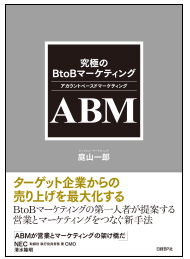I caught up recently with Ichiro Niwayama, founder of Symphony Marketing, the leading B2B-demand generation agency in Japan. His new book, Ultimate B2B Marketing: ABM, was published only last week, and has already leaped to #1 on the Amazon Japan business book list. Mr. Niwayama was kind enough to share his thoughts on where B2B marketing in Japan is headed, and why Account-Based Marketing will play an important part in its growth.
I posed six questions to Mr. Niwayama.
1. Why did you decide to focus your new book on Account-Based Marketing (ABM)?
In the US, there’s a lot of confusion about ABM. Everyone has a different definition, and there’s a lot of heated discussion about what it really means. But in Japan, the field is wide open. Marketing is not a big part of the B2B picture yet—but it should be. Our challenge is not the confusion, it’s the lack of marketing skill, performance, and influence. So we have a chance to introduce ABM techniques and concepts correctly the first time. I am defining ABM as “strategic marketing that aims to maximize sales revenue from defined target accounts, by integrating customer information within the organization and aligning marketing and sales.”
2. With what level of sophistication are companies in Japan practicing B2B marketing today? Where are they strong; and where do they need to improve?
I think Japan is 15 years behind the US. Consider this: fewer than 5% of Japanese B2B companies even have marketing departments. How is this possible? It’s because postwar Japanese growth came easily, in both foreign and domestic markets. All sales people had to do was go grab it, especially as they represented products of ever-improving quality. And the US government was guaranteeing an advantageous 360 yen to the dollar, which made us really competitive in foreign markets. This all changed with what we call the Lehmann Shock in 2008. Both our domestic and our international markets fell apart. The yen is now at 100 to the dollar. For growth, we need marketing. But companies don’t have the skills and the internal resources.
3. Why is ABM particularly relevant to the market in Japan?
The B2B go-to-market power in Japan resides with sales. Marketing is nowhere. The little marketing that exists is frankly irrelevant to sales. Marketers are measuring page views and clicks. But sales people care about matters like: What’s the buying power of this target company? What department does this prospect work in? These are ABM-type questions. So I believe that ABM is the route to introducing marketing thinking successfully in Japan. It’s thinking that is already consistent with the mindset of sales.
Also, there are structural reasons for ABM’s relevance here. Unlike the US, where decision-making is top down, and marketers are all chasing C-level targets, in Japan, decision-making is bottom up. A new business solution will only be adopted if it emerges from research and analysis at the middle management and worker levels. Selling here has never been about individuals. It’s about accounts.
4. What has Japan learned about ABM that US marketers can adopt?
Our tradition of account focus in something that US marketers might consider. This has always driven Japanese business-selling. So we have a natural strength in account-based thinking.
But I believe that we will have another strength to offer in the next few years, in the area of B2B data management. Our language is one of the most complex in the world, using words and writing from Chinese, Japanese, and Arabic sources combined. Moreover, Japan’s data privacy laws are among the strictest in the world. I predict that we will overcome these problems, and be able to share with you some useful methods for managing customer information. Check back with me later.
5. You’ve already written four books on B2B marketing. How does the ABM book fit into your publishing portfolio?
This is my fifth book. With this book my portfolio is complete. My first two were for beginners, on basic methods and concepts of marketing. The third was for the next level, about marketing frameworks, where I introduced lessons from marketing greats like Levitt, Aaker, and Kotler. My fourth was for B2B marketing professionals, covering marketing automation and demand generation. Now, with ABM, I have completed the circle, bringing Japanese marketers back to their roots.
6. Your book is the first on ABM in Japan. Do you have any plans to publish it in English?
No plans now. But if an English-language publisher is interested, of course I’m open.









